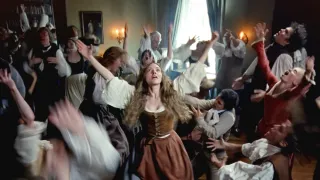January 10, 2017
Heart of a Dog
Jake Mulligan READ TIME: 4 MIN.
Artist Laurie Anderson's film "Heart of a Dog" has been released in three different iterations. There'd be no use in trying to determine the "best" one, but studying their differences can help us to see which forces direct the film itself. The Criterion Collection has released the theatrical cut of "Heart" which runs for 75 minutes, and features both audio and video (the former includes songs by Anderson, her late husband Lou Reed, and others.) But Criterion has also released a second, "no music" cut of the film (obviously shorn of those needle drops), which is included on the same disc. And Anderson has released yet another version herself (not included on this disc), though you may not call that one a "movie" as she distributed the audio track for the finished film as a music file, so you can also experience the work sans image. Thus the sole constant across the three releases are Anderson's spoken words, which continue throughout the film, as a feature-length one-woman monologue. This is the element that sits at the forefront. If you had to describe the texture of "Heart of a Dog" in any of its forms, then you'd begin by describing the sound of her voice.
And if you needed to describe the subject of Anderson's words, you'd do best to borrow one of her own phrases: her script revolves around the observation that "the purpose of death is the release of love." Which is to say more simply that love cannot be separated from the loss that inevitably follows it. That description of the film is sure to suggest thoughts of Reed, and of his relationship with Anderson. But he has no literal presence in the movie, at least until its final moments. The artist selects other avenues for traveling through this subject, most notably her loving relationship with her creatively-inclined rat terrier, Lolabelle (who also passed away recently), her more distanced relationship with her mother (whose own death is also recounted), her religious and philosophical beliefs (sometimes represented via text imposed on the frame), and various sociopolitical observations, many of which revolve around the apparatus we've come to call "the surveillance state." At the moment, this all plays like comments taken from the stream-of-consciousness, and flanked by further digressions, at that. One edit, which cuts from the perspective of a dog to the perspective of a security camera, may seem downright inexplicable in the moment. Others might too. But you realize along the time that the Reed song ushers in the credits that Anderson has been talking about the same thing this whole time. At the center of her film is the idea that human development can be measured by what we leave behind, whether that's a pet, a loved one, or the privacy of an entire society.
Given the manner in which these ideas are explicated, you may surmise that the film's qualities are mostly literary. And though its images are emphatic and expressive, analog-style scratch-effects provide a tactile appearance, while foregrounded images of rain and windows provide a sense of depth, they nevertheless do little to dispel the impression that this is primarily a lingual experience. What the images do represent, in a rather literal fashion, is whatever Anderson is speaking about at the given moment: words about her mother are backed by out-of-focus family portraits; personal memories are reenacted by mostly-silent actors; when she talks about the way dogs see in green and blue, the frame takes on the tint of those two colors. These frames support what she's saying, but they don't complicate the statements. There's a dialogue happening between the audio and the audience, but none between the words of the script and the images on the screen.
What's undeniable, regardless, is that the art of Laure Anderson bridges various disciplines. And Criterion's "Heart of a Dog" release works to illuminate how so. Extras include a theatrical trailer, a booklet featuring an essay by film critic Glenn Kenny, and, most significantly, a trio of videos that consider adjacent aspects of Anderson's creative output. The first clip, "Concert for Dogs," briefly documents a musical performance that Anderson held in Times Square. The second, "Lolabelle's Christmas Card," is one of numerous short video pieces Anderson made featuring the doggy mentioned above. And the final extra, a 40-minute-plus interview with Anderson (conducted by her producer Jake Perlin) features the artist discussing links between "Heart" and her other art projects. She speaks about that subject from various angles, such as connecting the relationship between audio and video in "Heart" to her use of visual art within live musical performances. She also speaks, at one point, about her disdain for the phrase "multimedia artist" which is a tempting label in this case, given the way she creates intersections between forms. But it'd be a misleading moniker all the same. Anderson is a storyteller, and it is her spoken narratives that give "Heart" its soul, more than any "multimedia." For better or worse, the images are just following along.
"Heart of a Dog"
Blu-ray
Criterion.com
$29.95






